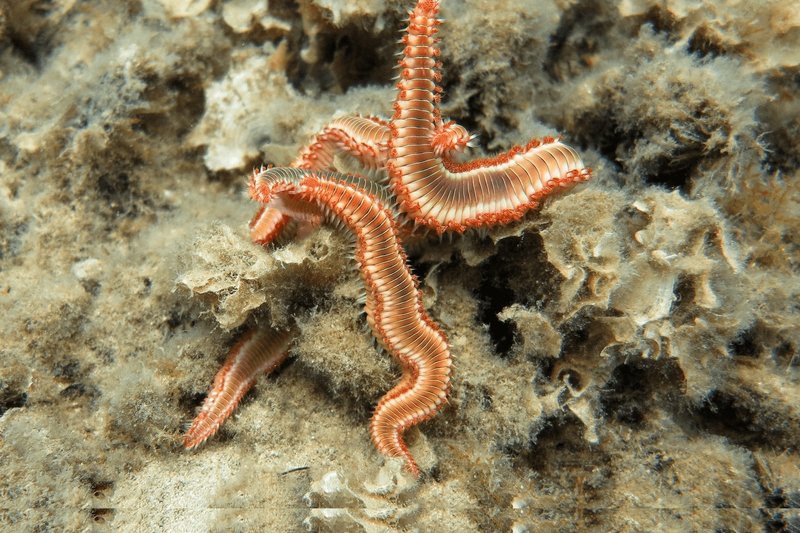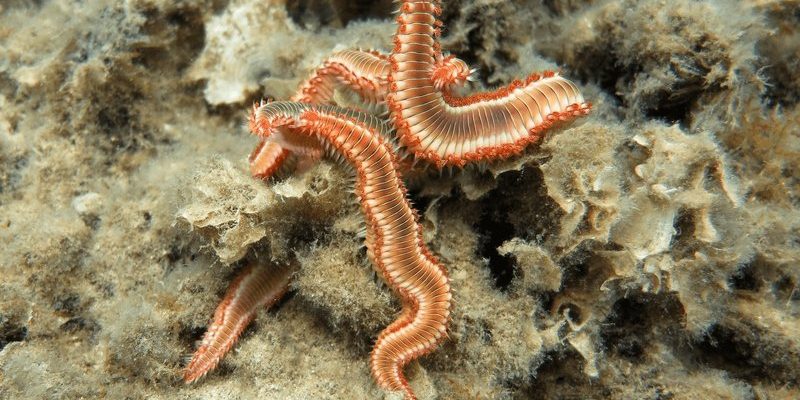
Think of bristle worms as the unsung heroes of the ocean floor. They’re like the vacuum cleaners of the sea, munching on decaying organic matter and keeping ecosystems tidy. The red tufts you see? They’re not just for show. These vibrant features play essential roles in the worms’ survival and their environment. So, let’s dig deeper into the world of bristle worms and uncover the meaning behind those colorful tufts.
What Are Bristle Worms?
Bristle worms are part of the class Polychaeta. They can be found in various marine environments, from shallow waters to deep ocean floors. These worms can vary widely in size, with some being just a few inches long, while others can stretch over a foot. The worms have a segmented body covered in bristles, or setae, which give them their name.
What’s interesting is that bristle worms come in many colors and patterns. Their appearance can range from muted greens and browns to bright reds and blues. The red tufts are a standout feature, and they can catch anyone’s eye. But they do a lot more than just look good!
The Role of Red Tufts
You might be curious about why these red tufts are so prominent. First off, these tufts are actually specialized extensions of their body called **parapodia**. Parapodia help in movement, allowing these worms to swim or burrow through the ocean floor. They also provide a surface area for gas exchange, letting the worms breathe underwater.
Moreover, the tufts can play a crucial role in attracting mates. In the vast ocean, the bright red colors can signal a healthy and vibrant partner. So, in a way, those tufts are like a stylish outfit, showing off the worm’s fitness and readiness to reproduce.
Why Are Red Tufts Important for the Ecosystem?
Bristle worms might seem small, but they have a big impact on their surroundings. Their role in the ecosystem is vital for a couple of reasons. First, they help break down organic materials. Think of them as nature’s recycling agents. By consuming dead plant and animal matter, they help return nutrients to the ecosystem.
Additionally, bristle worms are a food source for many predators, including fish, crustaceans, and even some sea birds. Their presence indicates a healthy marine environment. So, when you see those red tufts wiggling in the water, it’s a good indicator that the ecosystem is thriving.
How Do Red Tufts Help in Survival?
Survival in the wild can be tough, and the red tufts provide bristle worms with some advantages. One of the critical benefits is their ability to deter predators. The striking color can signal toxic properties or unpleasant taste, making potential predators think twice before snacking on them.
Moreover, red tufts may help camouflage them against certain backdrops, especially when they’re mixed in with coral reefs or colorful seagrasses. This stealthy strategy can make a significant difference, helping them avoid becoming someone else’s dinner!
Common Misconceptions About Bristle Worms
There are quite a few myths surrounding bristle worms. One common misconception is that they are dangerous. While it’s true that they have bristles that can sting, they’re generally harmless to humans. A touch might result in a mild irritation, but they’re not out to get us.
Another myth is the belief that all bristle worms are the same. In reality, there are thousands of species, each with unique traits and behaviors. The red tufts are just one of many fascinating aspects that make studying bristle worms so engaging.
How to Identify Different Species
Identifying which type of bristle worm you’ve encountered can be quite exciting. Generally, the size, shape, and color of the bristles can help you distinguish between species. For instance, some might have long, slender bristles, while others sport shorter, sturdier ones.
The red tufts are a distinguishing characteristic in many species, but not all bristle worms have them. If you’re scouting for worms, look for:
- Body segmentation: How many segments do you see?
- Color variations: Are there patterns aside from the red tufts?
- Size differences: Is it short and stubby or long and thin?
Taking notes on these traits can help anyone with an interest in marine biology or simply a love for the ocean.
How to Care for Bristle Worms in Aquariums
If you’re an aquarium enthusiast, you might find bristle worms sneaking into your tank. While they can be beneficial by helping maintain a clean environment, an overpopulation can be a problem. They can consume excess waste but also compete for food with your fish and corals.
To manage bristle worms in your tank:
- Monitor feeding: Avoid overfeeding your fish to limit the food available for worms.
- Maintain water quality: Regular water changes can help reduce their numbers.
- Introduce predators: Certain fish, like wrasses, will eat bristle worms, helping control their population.
By taking these steps, you can create a balanced environment for both your fish and the bristle worms.
Understanding the Benefits of Bristle Worms in Aquariums
Despite concerns about overpopulation, bristle worms can be beneficial in aquariums. They help break down waste and uneaten food, promoting a healthier environment. Their presence can speed up the nutrient cycle in your tank, which can be great for your plants and corals.
Plus, bristle worms add a bit of life to your aquarium. Watching them move around can be fascinating, as they scavenge and explore their underwater home. It’s like having a mini-ecosystem right in your living room!
So, what do those red tufts on bristle worms signify? They’re not just pretty colors; they tell a story of survival, reproduction, and ecological balance. From aiding movement to attracting mates, those tufts play various crucial roles in the bristle worm’s life and the underwater ecosystem.
Next time you see a bristle worm wriggling in the water, remember it’s more than just a strange-looking creature. It’s a vital component of its environment, helping to recycle nutrients and support a range of marine life. Understanding these small but mighty creatures enriches our appreciation of the marine world, making every beach trip or aquarium visit a little more special.

